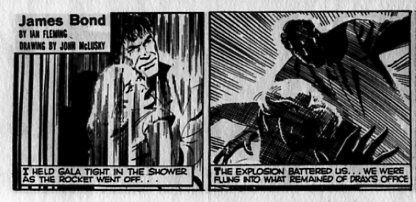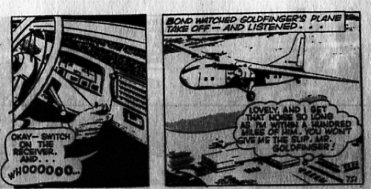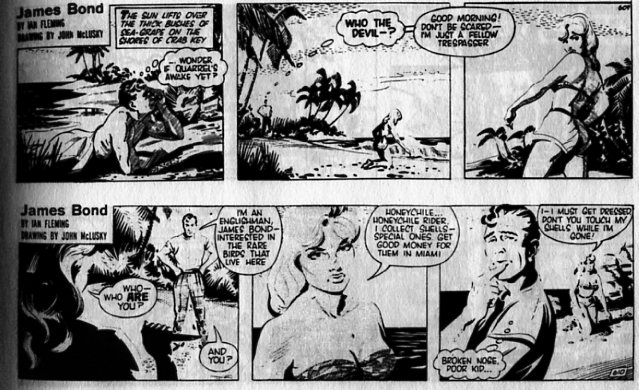
James Bond might not be a superhero, but he does dedicate his life to battling bad guys. Plus he has a codename: 007. Yeah, that means he’s just one guy in a league of 00s, so nothing unique—same as any Green Lantern in the intergalactic Green Lantern Corps. Maybe Earth-based agencies are different, but then that would strike Black Widow from the superhero census list too. Also, like Natasha, James has no superpowers, at least not compared to Thor or Superman. He’d make a pretty good match for Batman though. He even sports his own utility belt’s worth of Q-engineered supergadgets.
Mr. Bond also wields Dr. Who’s shapeshifting powers. I watched his edited-for-TV Sean Connery incarnation from my parents’ couch as a kid, and his Roger Moore from theater seats as an adolescent. I even witnessed his awkward Timothy Dalton stage while I was finishing college and his franchise was waiting for Pierce Brosnan to come-of-age too. But I have to admit Daniel Craig is the David Tennant of the Bond universe. I’m looking forward to seeing his current Spectre adventure.
The character struggled after losing his mission-defining Evil Empire, but Skyfall’s Judi Dench gave him back his raison d’être:
“I’m frightened because our enemies are no longer known to us. They do not exist on a map. They’re not nations. They’re individuals. Look around you. Who do you fear? Do you see a face, a uniform, a flag? No. Our world is not more transparent now. It’s all opaque. It’s in the shadows. That’s where we must do battle.”
Batman is all about shadows too, turning the darkness of his parents’ murders against the shady elements of murky Gotham. But, unlike a trigger-happy 00 agent, Batman would never kill anyone on purpose, right?
Well, actually the unlicensed Dark Knight racked up a Bond-level body count during his first year in Detective Comics. Not only did a holster hang from his utility belt back then, the batplane included a mounted machinegun: “Much as I hate to take human life, I’m afraid this time it’s necessary!”
DC editors reined in his homicidal writing staff after Batman #1, but even the comparatively wholesome Superman had a killing streak then. In June 1939, same month Batman was kicking jewel thieves off skyscrapers, Superman was dropping a mobster to an identical death. Granted, it wasn’t Superman’s fault he lost his super grip: “If he hadn’t tried to stab me, he’d be alive now.—But the fate received was exactly what he deserved!” Though what did Superman think was going to happen when he destroyed the Ultra-Humanite’s propeller mid-flight? The supervillain somehow escaped the crash, but no thanks to the death-indifferent Man of Steel.
Comic books usually protect their heroes from having to kill directly. In that same Action Comics, a rotating blade shatters against Superman’s impervious skull and slices up a nearby thug. Or in another early Batman adventure, a “foreign agent” is accidentally impaled on his own sword, and Batman self-righteously declares: “It is better that he should die! He might have sent thousands of others to their death on a battlefield if his plans had been successful!”
If this makes your feel morally queasy, listen to Spider-Man co-creator Steve Ditko on superhero morality: superheroes are “moral avengers” who must kill criminals in order to show “a clear understanding of right and wrong,” even if that means violating the “pervading legal moral” code.
Mr. Ditko currently resides in the crazy-old-man dimension of the comics multiverse, because his Ann Rand philosophy isn’t a page in today’s superhero bible. Batman’s and Superman’s most recent film incarnations take little license with the Sixth Commandment. In fact, the plot of Christopher Nolan’s 2008 The Dark Knight pivots on Christian Bale’s Batman struggling not to kill the Joker—even though killing him is necessary to protect others and exactly “what he deserves.” And remember the fan outrage when Henry Cavill’s Superman snapped General Zod’s neck in Man of Steel? It was that or let the General’s laser vision slice up a family of cowering Metropolitans, but Superman’s super-wholesomeness got sliced up too.
Both Zod and Joker are weirdly suicidal supervillains, goading their arch-enemies into committing murder. But then that’s the point. Superheroes are supposed to oppose killing out of principle. So where’s that leave Mr. Bond?
We could say his license strikes the “super” from his heroness, maybe even replacing it with an “anti.” His comic book counterpart might be the Ditko-esque Punisher, a sometime supervillain depending on who’s penning the story. But in James’ defense, killing isn’t the core of his mission. It’s just the most efficient means for getting important jobs down. He’s paid to be indifferent to death.
And that’s the problem. I remember Roger Moore’s 007 dangling a “foreign agent” by his tie from the edge of a building. The thug had been gunning at him seconds earlier, so the scene meets the “what he deserved” test. But was it necessary? Couldn’t he have holstered his license and knocked the guy out instead of dropping him to his death? Sure, the guy was a cog in the Cold War wheel trying to squash Democracy, but did Roger Moore have to grin? Did the movie have to play the scene for laughs, toying with the villain’s tie as he quivered for life?
I don’t blame his character though. James Bond was designed to be a cold-blooded Cold Warrior. You could argue the hero type was a product of its times—and so a bad fit with ours. Connery, Moore, Dalton, they all performed indifference so their 60s, 70s and 80s audiences could forget about the nuclear arsenal aimed at their hometown theaters. Take Bond out of that context and he just seems callous. The same way the original Superman and Batman made more moral sense as their readers teetered on the brink of a Nazi-driven World War.
The current Daniel Craig incarnation fixes that. He still shows his killer license when needed, but he’s not indifferent about it. He understands what it means to take a life. Like the 2013 Superman, he only snaps a villainous neck when it means saving innocent ones. He takes no pleasure in it. If anything, that hint of inner turmoil makes him almost superheroic. He does the dirty work so no one else has to. He’s not a 00 by self-righteous nature, but by self-sacrificing choice.




